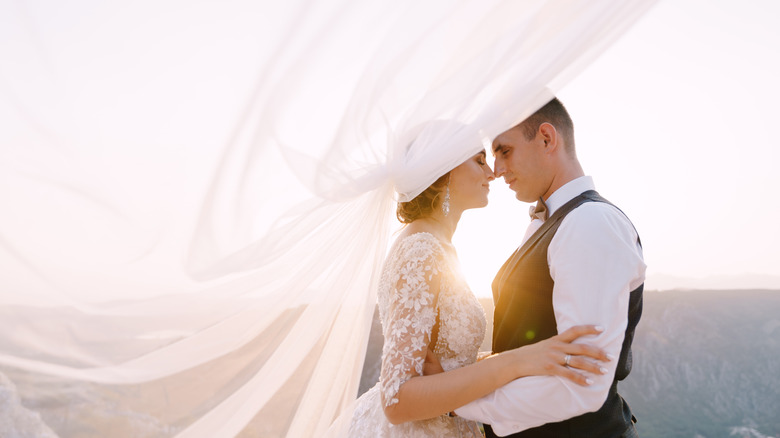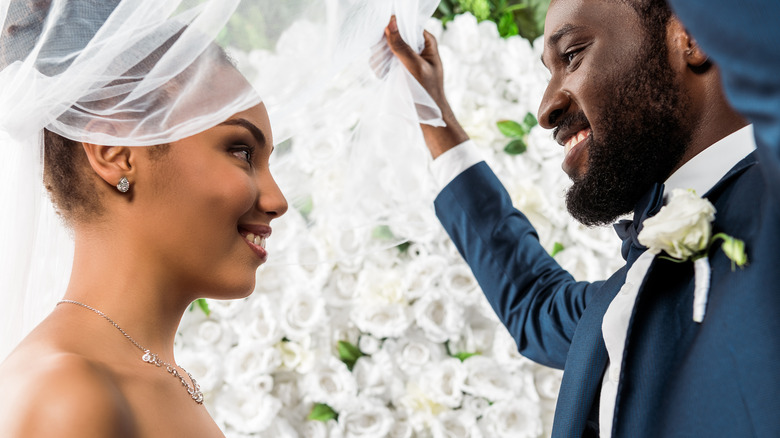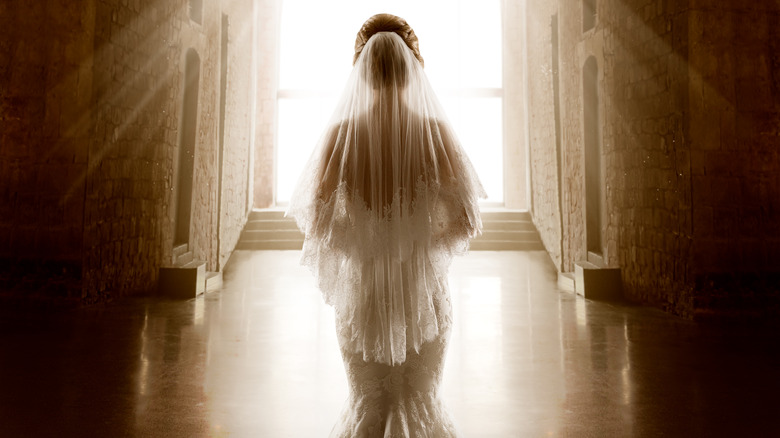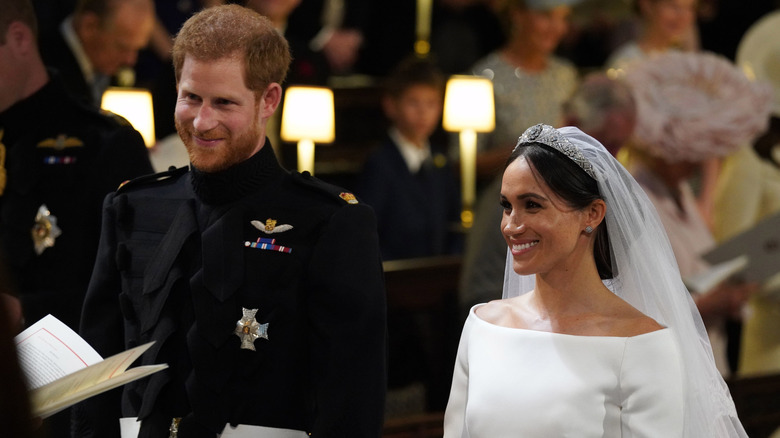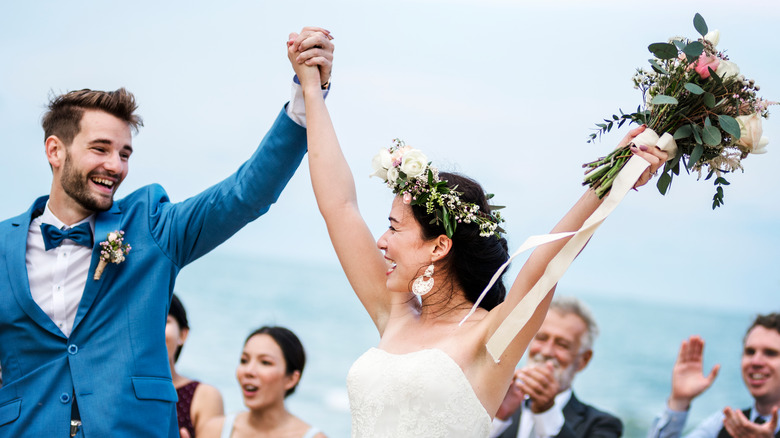Inside The History Of The Bridal Veil
Congrats, you're engaged! Or maybe you're . . . almost engaged? Okay, maybe you're just really curious about all things wedding history. No matter your proximity to walking down the aisle, you've probably thought about your wedding day. The dress, the flowers, and the choreographed first dance — it's all a part of creating the perfect big day. While wedding trends and traditions come and go, history is forever. And before you decide which traditions to incorporate into your wedding, it's important to know where these traditions came from.
One of the most historical pieces a bride can wear on her wedding day is a veil. Wedding historian and author Susan Waggoner told Brides that the veil is "the oldest part of the bridal ensemble." Veils are a piece of fabric, usually tulle or lace, worn on the bride's head that covers her face while she walks down the aisle. Once at the altar, the groom removes the fabric from her face, revealing the blushing bride. Today, many brides opt out of the face covering, but still wear the veil in their hair as a stunning bridal accessory (via The Knot). Whether it's a shoulder-length tulle headpiece worn to a courthouse ceremony, or a laced cathedral-length veil with the Virgin Mary embroidered on it, the veil remains an important part of weddings all over the world.
The real reason they covered the bride's face
Evidence shows that the concept of marriage has been around for over 4,000 years, according to The Week. As weddings changed over the centuries, different traditions were established — including the veil.
The veil can be traced back to weddings in Ancient Greece (via The Knot). Brides would cover their whole face and in many cases, shroud their whole bodies as they walked down the aisle. Susan Waggoner explained to Brides that veils "wrapped brides from head to toe to represent the delivery of a modest and untouched maiden." Let's be honest, delivering a bride pre-packaged like that Amazon box you've been waiting for doesn't sound super romantic.
Back then, marriage was not often about love, but about an exchange of property, money, or titles (per Brides). The Week reported it was also a way to ensure that any children a woman birthed were linked to their biological heir. Because of this, arranged marriages were the norm in most cultures, according to Richmond TImes-Dispatch, so the veil served as "a method of shielding the bride's face from her future husband." You know, just in case the groom saw his bride before the ceremony and was not attracted to her, noted Brides. Totally rude, but it happened!
The bridal veil's hidden meaning
Runaway grooms weren't the only thing the bride had to worry about back in the day. Couples and their families were extremely superstitious about their wedding day. What could they possibly be afraid of during such a happy and joyous occasion? If you guessed evil spirits, you're absolutely correct — it's always evil spirits.
According to Susan Waggoner in an interview with Brides, veils "hid her away from evil spirits who might want to thwart her happiness." Veils weren't always exclusive to just the brides, either. Bridesmaids were originally meant to be decoy brides that would confuse the evil spirits, with the veil helping to hide the identity of the real bride.
The Week reported that once weddings became more religious-based in the 1600s, brides wore veils to symbolize purity and innocence, so the fear of being cursed by the evil spirits definitely faded. But the fashion and elegance of the veil remained, with most brides choosing to wear one purely as an accessory (via Brides).
Royals set a high bar for brides
While the big white dress and veil seem like the standard wedding attire now, it wasn't always the case. For centuries, brides wore vibrant colors and avoided white, because it was so hard to keep clean. According to Brittanica, it was a symbol of serious wealth to wear a white dress because it meant you could afford to wear a dress only once. But that all changed with just one bride: Queen Victoria.
Susan Waggoner told Brides, "Queen Victoria was married in a white dress and a veil cascading down her back, making her the first modern monarch to be married in a veil." Queen Victoria inspired brides around the globe to find their own white lace wedding dresses and veils. And while brides today sometimes opt for colorful dresses or alternative bridal styles, the big white wedding that Queen Victoria wore is still very much the standard.
Queen Victoria wasn't the only royal to make a statement with her veil — Meghan Markle's gorgeous wedding day look included a 16-foot veil that stole the show as she glided down the aisle in 2018. People reported that it took "hundreds of hours" to make, and was worn with a bridal bun and a stunning tiara. The veil's detailing also had special significance: According to People, her veil "featured a trim of hand-embroidered flowers from each of the 53 counties in the Commonwealth in threads and organza."
Less veil, more sparkle
Lots of brides opt out of wearing veils nowadays. Maybe you don't like the idea of covering up your makeup that took three hours to perfect, or you're worried it will blow into your face right as you're saying "I do." Or you just learned the history of veils — a bit of patriarchal oppression, a pinch of superstition — and you've decided a traditional veil just isn't your style. There are still tons of beautiful alternatives that scream bridal (per Brides).
Some brides wear flower crowns down the aisle, capturing the trendy fairycore aesthetic. Other brides channel their inner princess with tiaras and crowns. These bridal headpieces from Cayla Couture capture the regal essence of being a bride while staying chic, modern, and totally unique.
The wonderful thing about a wedding is it can be completely customized, and all those wedding trends and traditions? Throw them right out the window if you want to. If headpieces and accessories aren't your things, nix them. No one is planning to wrap you up and deliver you to an altar anytime soon, so wear what makes you feel the most beautiful and confident.
